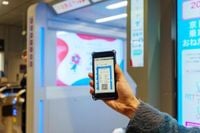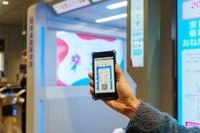The Digital Agency is making strides in enhancing the utility of the My Number Card, with a recent demonstration conducted by JR West illustrating the integration of digital enrollment certificates for university students with online student discount tickets. On March 24, 2025, a trial took place that aimed to facilitate a seamless travel experience through digital verification processes.
This groundbreaking experiment featured students from Osaka University who were expected to embark on overseas trips. Traditionally, students had to go through a multi-step process: physically applying for an enrollment certificate at the university, presenting this certificate at a public transportation window, and finally purchasing a student discount ticket. Each step involved several forms of verification and often resulted in time-consuming queues.
The new method streamlined these steps by allowing students to apply for and obtain their enrollment certificates online. After logging into the Osaka University website, students could store their digital enrollment certificates in a smartphone wallet app. This saved precious time and eliminated the hassle of visiting various campus offices or transportation hubs.
Once the enrollment certificate was secured, students logged into JR West’s electronic ticketing service dubbed "Machinoto Passport." They utilized a Digital Authentication App to confirm their identity using information from their My Number Card. This digital verification was critical for ensuring security and authenticity in an era where online transactions are rapidly spreading.
The student discount ticket purchase allowed them to pull up their digital enrollment certificate directly from their wallet app, which linked the ticket to their facial information registered at JR West’s face recognition gate. The implementation of this biometric technology is a novel approach toward reducing physical contact and improving the overall travel experience by enabling students to pass through gates touchlessly.
Several organizations collaborated to realize this project. The National Institute of Informatics (NII) took on the responsibility for digitizing the enrollment certificates, ensuring the creation of a Verifiable Credential (VC). This credential provides an authenticated digital format that can be easily verified by third-party services, cutting down on fraud. JR West leveraged this technology through its ID support system known as the Mobility Auth Bridge (MAB).
According to Kou Toriyaama from the Digital Agency, the initiative is a testament to the critical collaboration among industry, academia, and the government. Toriyaama expressed that this cooperative model not only paves the way for efficiency and ease of use but also reinforces the credibility necessary in managing personal data electronically.
Tomoyuki Sato, a professor at NII, elaborated on the importance of trust when it comes to digital enrollment certificates, stating, "Universities must ensure the authenticity of enrollment certificates. Even in a digital context, the perception of reliability must remain high."
As this project unfolds, it aims to address the objections to the cumbersome manual processes currently employed. By combining digital enrollment certificates and My Number Card functionalities, the project aspires to mitigate the burdens faced by not just students, but also railway operators and educational institutions.
Naoyuki Fujita from OpenID Foundation Japan noted that the necessity for a standardized technology is paramount as multiple stakeholders become involved in such systems. “Safety and scalability are crucial, and deploying uniformly accepted protocols will be key to long-term success,” he explained.
Moreover, the scope of this project reaches beyond immediate student benefits. The Digital Agency is investigating the potential for expanding this framework to include various universities and public transportation services across the country. This could see a future where learners from not just Osaka University but other institutions enjoy the same streamlined ticketing process.
The recent implementation of digital student IDs at Osaka University on January 29, 2025, aligns perfectly with these advancements. This move allows incoming students from April onward to present their digital student IDs via smartphone app, broadening access to discounted transport across most of Kansai’s transport facilities.
Wataru Mizunaga, associate professor at Osaka University, emphasized that with around 800 universities in Japan, creating unique systems for each would be unnecessarily cumbersome. He advocates for a standardized approach, stating, "We should aim to build a comprehensive and shared system that enhances Japan’s international competitiveness."
This initiative places Japan at the forefront of digital transformation efforts in educational and transport services. With positive momentum from this demonstration, stakeholders like JR West are keen on progressing discussions and fostering collaborative relationships with Osaka University.
Digital Minister Karen Makishima, who observed the experiment, remarked on the growing demand for online verification of qualifications alongside identity verification processes. “The hope is that this model can be expanded into various use cases,” she stated, reflecting on the potential to enhance operational efficiencies across sectors.
The ambitious plan includes future concepts such as collaboration with WESTER ID and the development of services catering to specific segments, including the elderly and disabled. The underlying goal remains simple: to remove friction from the ticket-purchasing experience and foster a more engaging relationship with railway travel among students.
In summary, the initiative by the Digital Agency and JR West represents a significant leap forward in utilizing technology for enhancing service delivery. Continued efforts into exploring areas for horizontal deployment and addressing emerging challenges will ensure that this pioneering model becomes a widely adopted standard, promoting efficiency and integration across education and transportation sectors.





